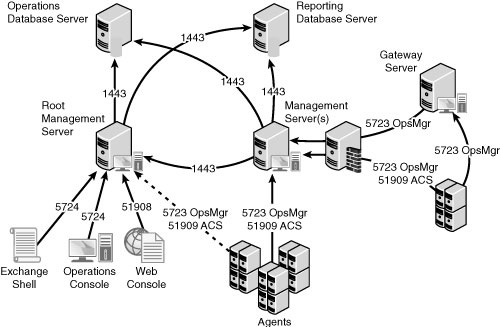Security
has evolved into a primary concern that can no longer be taken for
granted. The inherent security in Windows 2008 is only as good as the
services that have access to it; therefore, it is wise to perform a
security audit of all systems that access information from servers. This
concept holds true for management systems as well because they collect
sensitive information from every server in an enterprise. This includes
potentially sensitive event logs that could be used to compromise a
system. Consequently, securing the OpsMgr infrastructure should not be
taken lightly.
Securing OpsMgr Agents
Each server that
contains an OpsMgr agent and forwards events to management servers has
specific security requirements. Server-level security should be
established and should include provisions for OpsMgr data collection.
All traffic between OpsMgr components, such as the agents, management
servers, and database, is encrypted automatically for security, so the
traffic is inherently secured.
In
addition, environments with high security requirements should
investigate the use of encryption technologies such as IPSec to scramble
the event IDs that are sent between agents and OpsMgr servers, to
protect against eavesdropping of OpsMgr packets.
OpsMgr uses mutual
authentication between agents and management servers. This means that
the agent must reside in the same forest as the management server. If
the agent is located in a different forest or workgroup, client
certificates can be used to establish mutual authentication. If an
entire non-trusted domain must be monitored, the gateway server can be
installed in the non-trusted domain, agents can establish mutual
authentication to the gateway server, and certificates on the gateway
and management server are used to establish mutual authentication. In
this scenario, you can avoid needing to place a certificate on each
non-trusted domain member.
Understanding Firewall Requirements
OpsMgr servers
that are deployed across a firewall have special considerations that
must be taken into account. Port 5723, the default port for OpsMgr
communications, must specifically be opened on a firewall to allow
OpsMgr to communicate across it.
Table 1 describes communication for this and other OpsMgr components.
Table 1. OpsMgr Communication Ports
| From | To | Port |
|---|
| Agent | Root Management Server | 5723 |
| Agent | Management server | 5723 |
| Agent | Gateway server | 5723 |
| Agent (ACS forwarder) | Management server ACS collector | 51909 |
| Gateway server | Root Management Server | 5723 |
| Gateway server | Management server | 5723 |
| Management or Gateway server | UNIX or Linux computer | 1270 |
| Management or Gateway server | UNIX or Linux computer | 22 |
| Management server | Operations Manager database | 1433 |
| Management server | Root Management Server | 5723, 5724 |
| Management server | Reporting data warehouse | 1433 |
| Management server ACS collector | ACS database | 1433 |
| Operations console | Root Management Server | 5724 |
| Operations console (reports) | SQL Server Reporting Services | 80 |
| Reporting server | Root Management Server | 5723, 5724 |
| Reporting server | Reporting data warehouse | 1433 |
| Root management server | Operations Manager database | 1433 |
| Root management server | Reporting data warehouse | 1433 |
| Web console browser | Web console server | 51908 |
| Web console server | Root Management Server | 5724 |
The
agent is the component that ports need to be opened most often, which
is only port 5723 from the agent to the management servers for
monitoring. Other ports, such as 51909 for ACS, are more rarely needed. Figure 1 shows the major communications paths and ports between OpsMgr components.

Outlining Service Account Security
In addition to
the aforementioned security measures, security of an OpsMgr environment
can be strengthened by the addition of multiple service accounts to
handle the different OpsMgr components. For example, the Management
Server Action account and the SDK/Configuration service account should
be configured to use separate credentials, to provide for an extra layer
of protection in the event that one account is compromised.
Management Server Action account— The account responsible for collecting data and running responses from management servers.
SDK and Configuration service account— The account that writes data to the operations database; this service is also used for all console communication.
Local Administrator account— The account used during the agent push installation process. To install the agent, local administrative rights are required.
Agent Action account—
The credentials the agent will run as. This account can run under a
built-in system account, such as Local System, or a limited domain user
account for high-security environments.
Data Warehouse Write Action account— The account used by the management server to write data to the reporting data warehouse.
Data Warehouse Reader account— The account used to read data from the data warehouse when reports are executed.
Run As accounts—
The specific accounts used by management packs to facilitate
monitoring. These accounts must be manually created and delegated
specific rights as defined in the management pack documentation. These
accounts are then assigned as run-as accounts used by the management
pack to achieve a high-degree of security and flexibility when
monitoring the environment.